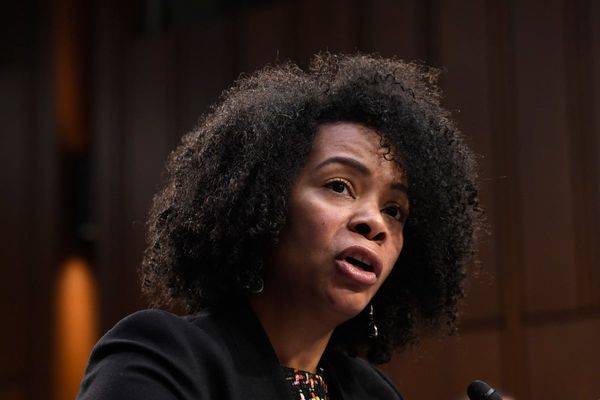
For more than eight years, the leaders of North and East Syria have pursued their project of self-rule in defiance of the Assad regime in Damascus. The Kurdish-led region has withstood the Islamic State, multiple Turkish interventions, a partial U.S. withdrawal, and the deployment of Russian troops.
Russian President Vladimir Putin seemingly believed the U.S. withdrawal last autumn would make it possible to finally achieve his foremost objective in Syria: to allow Bashar al-Assad to reclaim control over all Syrian territory. Putin calculated that the semi-autonomous region would easily fall back under control of the central government, the way rebel-held Aleppo or Homs collapsed once regime forces moved in. But that did not happen.
Instead of collapsing, the Autonomous Administration of North and East Syria continues to govern about a quarter of Syria from Raqqa in the West to Derik in the East, even paying salaries that are double those in regime-held territory. I visited northeast Syria for several weeks in September and witnessed myself how virtually all of the institutions of governance established by the autonomous administration continue to operate in defiance of Assad.
Schools continue to teach a new curriculum that features language instruction in Kurdish and Aramaic, in addition to Arabic. Teachers do not, however, peddle the Assad regime’s Baathist ideology meant to instill loyalty to Assad still taught in regime-held territory. Local courts continue to operate with their own system of jurisprudence, effectively abolishing numerous laws still upheld by the central government, such as the death penalty. Child marriage is still permitted under the Assad regime, but the autonomous administration’s leaders have enacted laws that aim to prevent it.
Perhaps disappointingly for Putin, the U.S.-backed Syrian Democratic Forces (SDF) have maintained their unified command structure. Instead of suffering defections in the face of the Turkish onslaught and deployment of Russian and regime troops, the SDF stood their ground. The SDF now has an estimated 100,000 fighters and includes internal security forces. It is the second-largest armed force in all of Syria, second only to Assad’s army.
Both Putin and Assad want the SDF to surrender to the Syrian Arab Army. This is key to reasserting regime control over the semi-autonomous region. But the commander-in-chief of the SDF, General Mazloum Abdi, has no plans to do so.
“We want to be part of the future Syrian army—but not the current one,” Mazloum told me in a lengthy face-to-face interview. The SDF and the autonomous administration have repeatedly confirmed that they are committed to the territorial integrity of Syria. They want to implement their project in other parts of Syria, not separate from Syria. And yet regime officials still refer to Syrian Kurds as migrants rather than Syrian citizens and accuse them of harboring separatist ambitions. Russian officials appear to either genuinely believe the anti-Kurdish propaganda or find it a helpful stick to use against them.
One carrot that officials in Moscow have often used is their offer to mediate talks between Damascus and the autonomous administration. So far, however, Assad has refused to make a single concession. I asked Mazloum why. Is it because the Russians are unable, or simply unwilling to pressure Assad into making concessions? “It’s because they don’t want to, they support the regime,” he said. “We received the Russians not because we wanted to, but because of the U.S. withdrawal.”
The SDF negotiated the terms under which the Russians could operate in their area. “One of the preconditions for the Russians to enter this area was that they should coordinate with us [the SDF], not the regime. So we always confront the Russians if they don’t abide by the agreement.” For now, Mazloum maintains that the SDF still has the upper hand: “The Russians are guests of the SDF, we accompany them on their patrols.” But the Russian military often tests the limits.
Because the Northeast has refused to submit to central government control, Russia has now shifted to new forms of subterfuge. These include demanding additional Russian bases in the Northeast, attempting to divide the SDF by inciting sectarian tensions between Kurds and Arabs, amplifying the Assad regime’s propaganda machine which refers to the SDF as “dissolved forces,” and further encroaching on U.S. troops in an attempt to force them to fully withdraw. There are an estimated 600 U.S. troops still in Syria. So far, these tactics have proven futile—but they have caused trouble.
The groundwork for today’s situation was laid a year ago. After a phone call with Turkish President Recep Tayyip Erdogan on Oct. 6, 2019, but no consultation with his own national security advisors, U.S. President Donald Trump ordered U.S. troops to withdraw from northeast Syria. Three days later, the Turkish military and their proxies surged across the border, occupying a large swath of territory between Tel Abyad and Ras al-Ayn.
The Russian military expanded its presence to more than 15 military bases, and promised to act as guarantor against further Turkish incursions. Officials in Moscow signed a cease-fire agreement with Ankara on Oct. 22, 2019 just days after Vice President Mike Pence had negotiated a similar agreement on Oct. 17. And yet neither the Russian nor U.S. agreement has prevented Turkey and Turkish-backed factions from committing over 800 cease-fire violations in the past year.
Last month, the Russian military demanded additional bases in the region. When the SDF refused, the Russian military threatened to withdraw. The focus of the dispute was on the sensitive Tel Tamer region, home to an ancient community of Assyrians who are struggling to defend their homeland after being assaulted by the Islamic State in 2015. Tel Tamer is now on the frontlines of the area occupied by Turkey and has suffered repeated attacks by Turkish-backed factions.
Russia’s threat to withdraw raises questions regarding the commitment of the Russian military to protect the region from further Turkish incursions, and may have been intended to force the SDF into making concessions. Local media reported that the Russians held meetings in Qamishli and Hasakah with seven different Arab tribes. The goal of the meetings was purportedly to convince them to defect from the SDF, and form a separate militia under Russian command.
The story of the SDF’s success in the face of pressures from Moscow, the Syrian regime, and Erdogan’s threats to launch yet another cross-border offensive cannot be attributed to U.S. patronage alone. Timber Sycamore, a covert billion-dollar program to train and equip other militia factions, resulted in unmitigated failure. The SDF draws its strength from its sheer diversity. It is the only armed force in Syria that does not discriminate on the basis of gender, ethnicity, or religion.
The unprecedented inclusivity of the SDF has helped to overcome sectarianism, which has been a major factor in making the Northeast the most stable region of Syria. Whether motivated by higher salaries, greater stability in the Northeast, a commitment to the new political system being established, or just a desire to escape Assad, Arabs from across Syria are enlisting in the SDF. I have interviewed Arabs from numerous regime and rebel-held cities who have left their homes and traveled great distances and at great risk, in order to join the SDF.
Not all Russian efforts have fallen flat. Recently, Foreign Minister Sergei Lavrov invited a delegation of the Syrian Democratic Council—the highest political body within the autonomous administration—to Moscow. The delegation signed a Memorandum of Understanding with the People’s Will Party, led by Qadri Jamil, calling for a united but decentralized Syria that recognizes all of its ethnic and religious components.
Putin’s partial success in Syria is in no small measure due to the simple fact that the Russian ministries of defense and foreign affairs coordinate their policies toward Syria. In the United States, disagreements between the White House, the Pentagon, and the State Department have at times been on open display, perhaps most dramatically when former Defense Secretary James Mattis resigned in protest because he was unwilling to carry out Trump’s initial withdrawal order in late 2018. The lack of a strong U.S. commitment to northeast Syria—other than Trump’s professed desire to “protect the oil”—also works in Russia’s favor.
A stronger U.S. commitment to northeast Syria does not have to entail a large or open-ended troop deployment. The past year has shown that even with a reduced military footprint, the United States is capable of carrying out anti-Islamic State missions across wide swaths of northern Syria, including the raid in Idlib that led to the death of Abu Bakr al-Baghdadi. However, the stabilization and humanitarian needs are enormous and the U.S. diplomatic presence is minimal.
An increased diplomatic presence would go a long way toward restoring trust since Trump’s botched partial withdrawal a year ago. A larger diplomatic presence is also necessary to ensure that wide-ranging U.S. policies are implemented on the ground. These policies range from stabilization efforts aimed to restore livelihoods and prevent a resurgence of the Islamic State, to sanctions on the Assad regime, to the repatriation of Islamic State detainees, to supporting the ongoing Kurdish unity talks.
In an effort to overcome political deadlock, Mazloum took the initiative to begin unity talks between rival Kurdish parties. In contrast to the Russian-sponsored talks between the region’s leaders and the Assad regime, which have gone nowhere, the U.S.-sponsored Kurdish unity talks are slowly making progress.
If they succeed, the Kurdish unity talks could pave the way to greater political pluralism in northeast Syria, and potentially reduce tensions with both Turkey and Iraqi Kurdistan. This could have a transformative impact on the larger region and make it possible for the U.S. military to eventually withdraw or downsize—without throwing the region into chaos, endangering the lives of some four million people, or betraying U.S. allies.
To increase the prospects of the unity talks succeeding, the United States should commit to including the autonomous administration in the U.N.-sponsored talks in Geneva that aim to find a political resolution to the conflict.
It’s time that Washington stop treating the SDF as just a tool to defeat the Islamic State. The SDF and autonomous administration have also held territory after liberating it from the Caliphate, made the Northeast the most stable region of Syria, and have refused—for more than eight years—to surrender to Assad. An alternative to the Assad regime is already on the horizon; the U.S. government just needs to acknowledge it.







